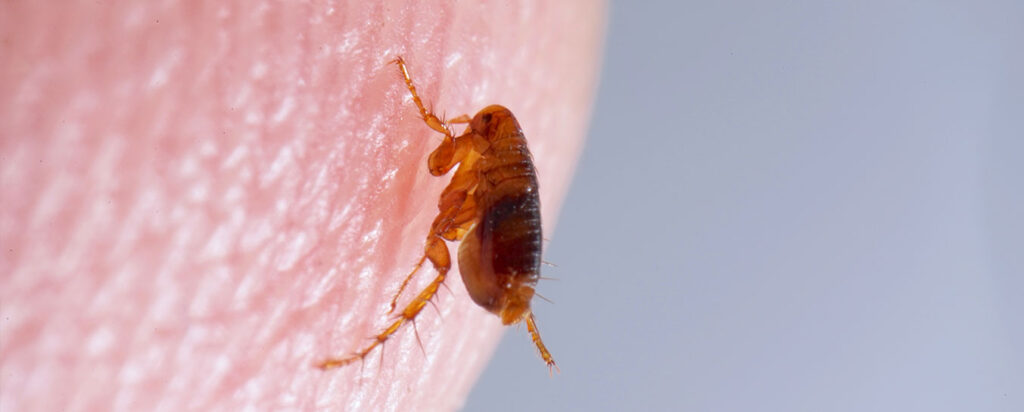Fleas

Ask About Our
100% Eco-Friendly
Options

Flea Control In Central Wisconsin

Understanding and Combating Fleas: A Comprehensive Guide for Homeowners
Fleas are a well-known and somewhat scary pest for homeowners, especially those with pests. They are small, wingless insects around 2.5mm long with shiny, reddish-brown bodies. While they do not have wings, they are capable of jumping long distances which makes it easier for them to travel from animal to animal. They are holometabolous insects, which means they go through four complete lifecycle stages: egg, larva, pupa, and adult. Flea populations have an approximate distribution of 50% eggs, 35% larvae, 10% pupae, and only 5% adults, and adults must feed on blood before they can reproduce.
Flea infestations are next to impossible to handle by yourself and require the help of multiple professionals. While you will want to trust a professional pest control service like 1st Choice Pest Control for flea removal from your property, you’ll also need to address the source of the fleas which is likely a pet. This means you’ll need to simultaneously coordinate with your pest control company and your veterinarian to attack the problem from all sides. In addition to being a nuisance fleas can be dangerous for humans and pets alike causing:
- Irritating Bites
- Allergic Reactions
- Disease Spread
Flea Life Cycle
Eggs
The flea life cycle begins when the female lays after feeding. Eggs are laid in batches of up to 20 or so, usually on the host itself, which means that the eggs can easily roll onto the ground. Because of this, areas where the host rests and sleeps become one of the primary habitats of eggs and developing fleas. The eggs take around two days to two weeks to hatch.
Larvae
Flea larvae emerge from the eggs to feed on any available organic material such as dead insects, feces, and vegetable matter. In laboratory studies, some dietary diversity seems necessary for proper larval development. Blood-only diets allow only 12% of larvae to mature, whereas blood and yeast or dog chow diets allow almost all larvae to mature. They are blind and avoid sunlight, keeping to dark places such as sand, cracks and crevices, and bedding.
Pupae
Given an adequate supply of food, larvae pupate and weave silken cocoons within 1–2 weeks after three larval stages. After another week or two, the adult fleas are fully developed and ready to emerge. They may remain resting during this period until they receive a signal that a host is near - vibrations (including sound), heat, and carbon dioxide are all stimuli indicating the probable presence of a host. Fleas are known to overwinter in the larval or pupal stages.
Adult
Once the flea reaches adulthood, its primary goal is to find blood and then to reproduce. Its total life span can be as long as one and one-half years in ideal conditions. Female fleas can lay 5000 or more eggs over their life, allowing for phenomenal growth rates. Average 30–90 days. A flea might live a year and a half under ideal conditions. These include the right temperature, food supply, and humidity. Generally speaking, an adult flea only lives for 2 or 3 months. Without a host for food, a flea's life might be as short as a few days. With ample food supply, the adult flea will often live up to 100 days
Frequently Asked Questions
Signs of fleas on pets include excessive scratching or biting, hair loss or redness on the skin, and small black or brown fleas visible on the skin or fur.
Fleas can enter your home on pets or on items such as clothing or furniture that has come into contact with fleas. They can also enter through cracks or gaps in walls or floors.
Effective flea treatments may include flea shampoos or medications for pets, vacuuming and washing all bedding and furniture, and using insecticide sprays or foggers. It’s best to consult with a pest control professional for the most effective treatment plan.
To prevent a flea infestation, regularly groom and treat your pets for fleas, vacuum and wash all bedding and furniture, and seal cracks and gaps in walls and floors
Flea Prep List
Before Treatment
- Move all furniture at least two (2) feet away from walls.
- Have all drawers in dressers, nightstands, vanities, and armoires removed and emptied for inspection. Store contents in sealable plastic bags or tightly secured garbage bags.
- Wash/dry clothes, bedding, and linens
- Wash clothes, bedding, and linens with laundry detergent using the hottest water temperature setting that is practical. Next, place all “dryer safe” items in the dryer on high heat for at least 20 to 45 minutes. Store items in sealable plastic or tightly secured garbage bags after drying.
- Place “dry clean only” items in sealable plastic or tightly secured garbage bags and brought to the dry cleaners. Dry cleaners should be notified of the infested items so the infestation does not spread within the facility.
- Place both the mattress and box spring on their side along with removing the felt – the pest control company will need to have access to the underside of the bed. Remove everything from the headboard(s). Wash/dry as appropriate, and store all items in sealable plastic or tightly secured garbage bags.
- Remove all children’s toys and any other items that children can put in their mouth, especially those items on the floor, from the infested rooms. Place washable/dry-able items in the dryer on high heat for 20 to 45 minutes. Items may also be put in sealable plastic bags or tightly secured plastic garbage bags and then placed in the freezer for four days, if practical. After washing/drying or freezing, store all items in sealable plastic bags or tightly secured garbage bags.
- Remove all items found on the floor of closets and underneath the beds in infested rooms, wash/dry as appropriate, and store in sealable plastic or tightly secured garbage bags.
- Remove all pet bedding, wash/dry as appropriate, and store in sealable plastic or tightly secured garbage bags.
- Place all sealed or secured plastic bags in an area where they will not restrict access to infested rooms.
- Vacuum floors and use a crevice tool/wand around moldings of the room(s) to be treated. Thoroughly vacuum all furniture, mattresses, pillows, upholstery, and curtains. It is very important to focus on creases, buttons, cording, and folds. After vacuuming, dispose of the vacuum bag or the contents of the bagless vacuum canister in a plastic bag. Seal the bag tightly and immediately dispose of it in a garbage container outside the home. Thoroughly wash the bagless vacuum canister with hot soapy water to eliminate any bed bugs and eggs. Clean or mop all vinyl, ceramic, and wood floors.
- Unplug electrical equipment such as computers, TVs, alarm clocks, etc., in rooms to be treated. Remove electrical wall plates. This will allow the pest control operator to treat wall openings.
- Notify pest control operator of any allergies, chemical sensitivities, or similar medical conditions prior to treatment.
- We strongly recommend that small children, elderly persons, people with respiratory problems, and pets vacate the premises during the treatment. They should stay away for at least four (4) hours or until any treatment product has dried, whichever period is greater.
- Inform building management if assistance is needed to complete any of the above tasks.
After Treatment
- Leave your home for at least four (4) hours or until any treatment product has dried, whichever is greater. Keep pets and children off treated surfaces until any treatment product has dried.
- Do not make bed until treatment is finished and beds are dry.
- Do not sleep in the room for a minimum of four (4) hours or until any treatment product has dried, whichever is greater.
- Inspect and clean all items before returning them to areas underneath the bed or in the closet.
- Depending on your treatment plan, you may need to keep clothing, coats, shoes, linens, and other fabric-based items in plastic bags for anywhere from several weeks to ensure that your items do not become re-infested. Be sure to check with the pest control operator or landlord for a date when you can safely return belongings to closets or dressers.


 Service Request
Service Request